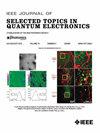980 nm QW超低阈值微激光器
IF 5.1
2区 工程技术
Q1 ENGINEERING, ELECTRICAL & ELECTRONIC
IEEE Journal of Selected Topics in Quantum Electronics
Pub Date : 2025-03-23
DOI:10.1109/JSTQE.2025.3573291
引用次数: 0
摘要
在光通信系统中,980纳米激光器是泵浦掺铒光纤放大器(edfa)的关键,在新兴的生物应用中也越来越受到关注。为了实现高密度集成和低功耗,我们在GaAs和Si衬底上开发了高性能980 nm微型激光器。这项工作结合了量子阱(QW)有源区域与微腔,包括微环激光器(MRLs)和微盘激光器(MDLs)与优化的金属设计。采用先进的钝化技术抑制侧壁表面复合,显著提高了激光性能。在这里,我们报道了980 nm的电泵浦QW微激光器的首次室温连续波(CW)操作。实现2.4 mA的低连续波阈值电流,并在超过95℃的高温下工作(测量设置极限),激光器在脉冲模式下也表现出亚毫安的阈值。优化后的微激光器在6个月的存储时间内几乎没有退化,表现出稳定性。我们讨论了量子w微激光器的局限性,相应的解决方案,以及潜在的物理。由于其占地面积小,阈值低,在初步测试中性能稳定,QW微激光器是有前途的片上光源,用于密集光子电路集成。本文章由计算机程序翻译,如有差异,请以英文原文为准。
980 nm QW Micro-Lasers With Ultra-Low Threshold
980 nm lasers, critical for pumping erbium-doped fiber amplifiers (EDFAs) in optical communication systems, are also gaining traction in emerging biological applications. To achieve dense integration and low power consumption, we developed high-performance 980 nm micro-lasers on both GaAs and Si substrates. This work combines quantum well (QW) active regions with micro-cavities, including micro-ring lasers (MRLs) and micro-disk lasers (MDLs) with optimized metal designs. Advanced passivation techniques were applied to suppress sidewall surface recombination, significantly improving laser performance. Here, we report the first room-temperature continuous-wave (CW) operation of electrically pumped QW micro-lasers at 980 nm. Achieving a low CW threshold current of 2.4 mA and operation at elevated temperatures exceeding 95 °C (measurement setup limit), the lasers also demonstrated sub-milliamp thresholds in pulsed mode. The optimized micro-lasers exhibited little degradation over six months of storage, showing stability. We discuss the limitations of QW micro-lasers, corresponding solutions, and the underlying physics. With their small footprint, low thresholds, and stable performance under preliminary tests, QW micro-lasers are promising on-chip light sources for dense photonic circuit integration.
求助全文
通过发布文献求助,成功后即可免费获取论文全文。
去求助
来源期刊

IEEE Journal of Selected Topics in Quantum Electronics
工程技术-工程:电子与电气
CiteScore
10.60
自引率
2.00%
发文量
212
审稿时长
3 months
期刊介绍:
Papers published in the IEEE Journal of Selected Topics in Quantum Electronics fall within the broad field of science and technology of quantum electronics of a device, subsystem, or system-oriented nature. Each issue is devoted to a specific topic within this broad spectrum. Announcements of the topical areas planned for future issues, along with deadlines for receipt of manuscripts, are published in this Journal and in the IEEE Journal of Quantum Electronics. Generally, the scope of manuscripts appropriate to this Journal is the same as that for the IEEE Journal of Quantum Electronics. Manuscripts are published that report original theoretical and/or experimental research results that advance the scientific and technological base of quantum electronics devices, systems, or applications. The Journal is dedicated toward publishing research results that advance the state of the art or add to the understanding of the generation, amplification, modulation, detection, waveguiding, or propagation characteristics of coherent electromagnetic radiation having sub-millimeter and shorter wavelengths. In order to be suitable for publication in this Journal, the content of manuscripts concerned with subject-related research must have a potential impact on advancing the technological base of quantum electronic devices, systems, and/or applications. Potential authors of subject-related research have the responsibility of pointing out this potential impact. System-oriented manuscripts must be concerned with systems that perform a function previously unavailable or that outperform previously established systems that did not use quantum electronic components or concepts. Tutorial and review papers are by invitation only.
 求助内容:
求助内容: 应助结果提醒方式:
应助结果提醒方式:


